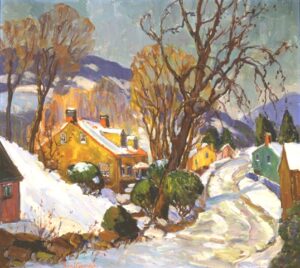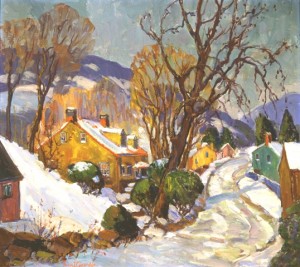Happy 96th to The Philadelphia Ten!


This past February 17th marked the 96th anniversary of the revolutionary and innovative first art show of “The Philadelphia Ten”. This exhibition included two hundred forty seven paintings of varying subject matter – from landscapes to still-lives to portraiture, created by eleven women and opened at the Art Club of Philadelphia. This show opened the door for sixty-five more art shows of this nature at a time when female artists, let alone female art shows, were unheard of. The eleven initial members were: Eleanor Abrams, Katherine Marie Barker, Theresa Bernstein, Cora S. Brooks, Isabel Branson Cartwright, Constance Cochrane, Mary-Russell Ferrell [Colton], Arrah Lee Gaul, Edith Lucile Howard, Helen Kiner McCarthy and Katherine Hood McCormick. Most of these women studied together at the School of Design for Women, today known as Moore College of Art and Design.
Although there had been occasional showings of female art through various art clubs in the past, this show was monumental because all the artists were females trained in Philadelphia. In addition, this show was different because there was a decision to limit who could participate and each artist exhibited a large amount of work at one time. This exhibit marks and highlights the fact that for the first time women artists took back control of their careers and chose how they would exhibit their work and where. And, these women were all from the Philadelphia area – a point important to me particularly, as it shows the open-minded, innovative heritage and spirit of our great city and state.
Over the next thirty years, some members left and many new ones joined including Fern Coppedge, one impressionist painter found in the Michener’s collection. Many of these women studied at the School of Design where many famous male Bucks County artists taught, such as Daniel Garber and Henry Snell. The Bucks County influence is evident in the works of these women, and their efforts truly helped to further enhance and bring the world’s attention this local impressionistic style.
Not only were these women innovative when it came to their views on female artists and their careers, but they were also very forward thinking when it came to lifestyle choices. In general, about half of the members of this group never married; of those who did marry, many chose to not have children and kept their maiden names. All of these things seem perfectly normal to us today. These women were truly making revolutionary and often looked-down upon decisions openly and with fervent courage. They used their art as a means of income and creative expression, and achieved economic and professional success in a field that wasn’t guaranteed and in a male dominated art world.
In researching these women, I am genuinely proud of and grateful for them. How do you feel about these women? Do you have females in your life that have truly influenced you and helped you see outside of the box?
Please share your thoughts with us!
– Sumreen Z. Chaudhry, Michener Intern